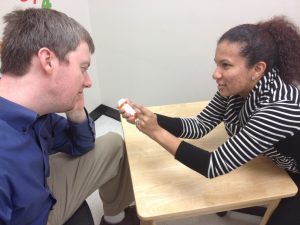As our appointment came to an end, I took a few minutes to give final instructions to my patient. Though she had many medical issues, she had unfortunately been absent from my clinic for almost six months, making this appointment particularly important and valuable.
I observed as she leaned in and struggled to understand the problems that I attempted to address. As I did, it became apparent to me that not everything was being accurately translated. I paused and asked if she understood. She nodded, though I suspected this was not the entire truth.
 Still determined to get through, I grabbed a sheet of paper and wrote the simplest information that I could to explain her health concerns. Again, I probed to see if she could understand with the words now in writing. She regarded the paper with a quizzical look but glanced back to me and said, “I’ll try, but if not, I’ll get someone to help me.”
Still determined to get through, I grabbed a sheet of paper and wrote the simplest information that I could to explain her health concerns. Again, I probed to see if she could understand with the words now in writing. She regarded the paper with a quizzical look but glanced back to me and said, “I’ll try, but if not, I’ll get someone to help me.”
And then, things became clearer to me.
Health literacy is certainly not a new issue. The Institute of Medicine and the U.S. Department of Health and Human Services define health literacy as the “degree to which individuals have the capacity to obtain, process and understand basic health information and services needed to make appropriate health decisions.” It is estimated that about 15 percent of American adults have poor health literacy, and this proportion is higher among the elderly.[1] This problem is perhaps even more acute in urban clinics like my primary care clinic in East Baltimore.
Katie Shaw, M.D., a fourth-year internal medicine and pediatrics resident at Johns Hopkins, sees the impact of poor health literacy regularly and has identified ways to bridge the literacy gap in her clinic.
“There are simple things, like using the teach-back method or simply asking the patient what they understand about their medical condition, that provide a lot of insight for me as a provider,” said Dr. Shaw, who did health literacy research as a medical student at Vanderbilt. The teach-back method allows the patient to explain their understanding of the medical plan to the provider, who can make sure that both parties are on the same page. Dr. Shaw also recommends utilizing nurse case managers, home care nurses and pharmacists to reach out to patients with low health literacy.
“Taking a small amount of time to work to make sure patients understand and are engaged in their health plans goes a long way,” said Dr. Shaw.
Lucky for me, I got another try at explaining such topics to my patient who was admitted to the hospital just a few days after our previous meeting. Visiting her, I thought back to our challenging conversation in that small clinic room. Now there was more to share and more to explain.
I sat down next to her with a smile and asked her how she felt. Success would not come overnight. However, with a new approach to talking through issues with this patient and others with low health literacy, I am confident that together we can help her achieve better health.
[1] Kutner M, Greenberg E, Jin Y, et al. The health literacy of America’s adults — Results for the 2003 national assessment of adult literacy. Washington, DC: US. Department of Education; 2006:i–60. Available at http://nces.ed.gov/pubs2006/2006483.pdf. Accessed April 7, 2015.